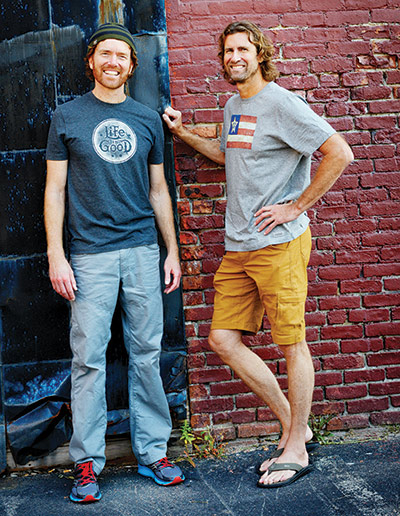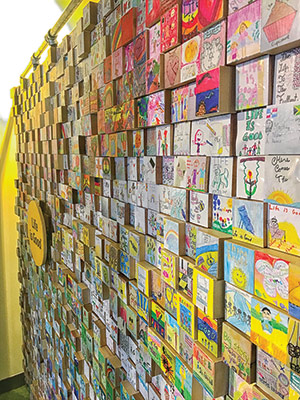 By Victoria Garcia
By Victoria GarciaThe colloquialism “life is good,” is commonly incorporated into everyday conversation. Mostly we use this phrase to express excitement and enthusiasm or when something wonderful happens in our lives. Until 1994, this phrase was used by many without a proper meaning behind them. But these three words changed the lives of brothers Bert and John Jacobs, who set out to turn the phrase into a lifestyle while positively spreading the power of optimism.
In 1989 after graduating college, Bert and John decided that selling T-shirts would be a fun way to make a living and create art at the same time. Without any experience, the brothers bought “The Enterprise,” a used minivan that they drove up and down the East Coast selling T-shirts door to door and on the streets. After five years of surviving on peanut butter and jelly and living in their beloved van with only $78 to their names, they almost gave up on their dreams but a discussion about negative news and its connotations led to the idea behind their brand Life is Good. In 1994, the brothers created a drawing of Jake, the original Life is Good character. Jake, who expresses a grin and a somewhat comedic demeanor would be the cartoon to help them successfully sell their first set of Life is Good merchandise at the Cambridge Street Fair. Jake was immediately embraced by customers who were looking for a simple, yet positive message. Soon, this message would spread all across the country.
Born and raised just outside of Boston in Needham, Mass., Bert and John were the youngest two of six siblings. Their parents, Al and Joan, made ends meet but struggled to raise a family of six children on a small salary. Although they experienced an imperfect and chaotic childhood, Bert and John found solace and optimism in their mother. “Our mom was definitely the number one inspiration for our brand,” says John. “She handled a lot of adversity as we were growing up, she had six kids and we had as much dysfunction as most families but she was incredibly positive.”
Each night at the dinner table, their mother would ask each child to tell her something good that happened that day and concentrated on focusing on the positive. “We think optimism is a choice you can make, and we learned that from our mom and from people who have faced greater adversity. People who face the worst adversity seem to have this elevated sense of gratitude and clarity of what’s important in life.”
Without knowing what the future held, both Bert and John focused on spreading good vibes and optimism through their Life is Good merchandise. “Once we found something that resonated and really spoke to our values, which was Life is Good, we realized the business could be a vehicle for good,” says John. Once customers became aware of their enthusiastic mindset, the brothers starting receiving letters from those affected and influenced by their messages. Not only were people sharing their positive outlook on life but they were also sharing stories of overcoming adversity, disease and loss. “We’ve found through learning from our customers along the way, people facing great adversity that sent these inspiring letters to us about how their hat or their T-shirt helped them stay positive. But really it’s their choice to focus on the good, even though they’re facing chemo or losing loved ones, that’s what really led us to grow this brand.”
Many of these stories can be seen on the Life is Good website, which features a Hub of Optimism for customers to share their stories and insights offering yet another way to spread the brand’s message. After reading and reviewing all of their customers inspiring and moving stories, John and Bert realized that children were especially conveying the Life is Good mantra. “The artwork was kind of child-like at first, and from these inspiring letters we realized our brand resonated with families.” They believe that children are the ultimate optimists and need to grow up in a healthy environment in order to stay positive in a world that is constantly exposing adversity and trauma to these young minds. “A healthy kid tends to grow up with arms wide open, and they are exploring the world, trying new things and meeting new people,” explains John. “We found that when kids were exposed to various forms of trauma whether its poverty, violence or illness at a young age, it’s much harder to live your life wide open and kind of explore the world in an optimistic manner.”
The necessity for children to experience positivity and learn how to deal with hardships led to the creation of the Life is Good Kids Foundation. The foundation helps to support childcare professionals such as counselors, social workers and teachers, who are dedicated and passionate about their careers in helping children. Known as Life is Good Playmakers, these individuals are provided with professional and personal development resources that help them understand and spread the power of optimism to form life-changing relationships with children. “We created the Kids Foundation many years ago to try and help those kids work through the difficult trauma that they’ve been exposed to,” says John. “We do that by working directly with health care providers, teachers, counselors, those who we think are the real heroes in the trenches every day. When we started the foundation, we worked directly with the kids, and we realized we could have more of an impact by working with those people who are childcare providers that have the most contact with these kids.” The foundation has now trained over 8,000 playmakers who are positively impacting thousands of children on a daily basis, and 10 percent of the Life is Good net profit is now donated to the foundation.
Originally starting off with Jake’s cartoon face printed on T-shirts, the brothers successfully expanded Life is Good to much more than their original designs. Now the brand has extended its product into more apparel, accessories, home goods and other miscellaneous items that all share the same optimistic appeal. Their newest venture brings the brothers and their brand into the eyewear scene alongside The McGee Group, with optical, sun and reader styles for men, women, teens and kids that are all inspired by places, people and works of art. “It seemed like a really natural extension of the brand for a lot of reasons,” says John. “Eye doctors every day are helping people to see more clearly, and we try every day to help people to focus on the good, and we believe what we focus on will grow.” In the past 20 years, the brothers mostly see their brand out in the world during outdoor excursions such as on the mountains or the beach, so extending into eyewear, especially sunwear, was a natural move to inspire consumers to actually live outdoors without the complexity of technology and life.
The collection is fun and upbeat with bright colored acetates and modern shapes and comes with a coordinating zippered color case. On the interior temple of each frame, the phrase “spread good vibes” is placed to further emphasize the message of the brand. Each optical frame is named after a hero of optimism whose story resonated with the brand and reminds everyone to focus on the good in life. The point-of-purchase materials for the collection are fun-loving and simple, and consist of Jake’s image on a standing display. “What we focus on grows,” another Life is Good mantra, is also written on a few of the displays as well as the brand’s bright yellow logo. “We’re happy to be able to deliver positive messages that have humor, fun, depth and wisdom,” says John. “And to be able to do that in a really fun category, it just kind of makes you smile to look at these sunglasses and eyewear.” The McGee Group and Life is Good are both extremely enthusiastic about philanthropic endeavors, and this eyewear collection is no exception. “For us to create new fun products that help spread positive messages is a dream to us, and McGee has been a fantastic partner for us in this realm.” Both companies are very adamant about creating inspiring and reasonably priced products that help spread the Life is Good messages as well as making the eyewear accessible to their customers.
Similar to all the Life is Good merchandise available, the new eyewear collection focuses on the bigger picture. Although the product is important, the messages behind the product are even more relevant. With small but powerful messages inscribed onto frames and merchandising materials, the collection puts a greater emphasis on what life has to offer through positivity and openness. “If we’re just slapping our name on something, I don’t think that leads to anything positive,” says John. “We sincerely believe that we’re going to get those messages in front of a lot more people and maybe give them a little bit of a lift that they need on harder days. If we do those things for the right reason and then put all that love into the actual product. Let’s spread this message to more people, and let’s help more kids.” We’d say they’re definitely off to a great start. ■
EXPERIENCING THE GOOD LIFE

This past April, I was given the opportunity to visit the Life is Good headquarters in Boston, alongside The McGee Group’s Katherine Corbett. It was an exciting way to get an inside scoop on the brand and learn more about their mission and day-to-day operations. Although it was a cloudy day, the Life is Good office space was open and bright, and the employees were extremely friendly and welcoming. As soon as I stepped onto the wooden floors of this office, I knew this was no ordinary workspace. The Life is Good team encompasses two floors filled with a buzzing atmosphere. I was given a tour of the space which included a kitchen, bar and several conference rooms. Life is Good logos, apparel designs, mood boards, and inspirational words were scattered all around as a constant reminder of the brand’s key messages.
During the tour, I was presented with a small wall filled with tiny pictures. These illustrations were part of a design contest Life is Good launched where customers and fans have the opportunity to submit a T-shirt design to potentially be made for the brand. This was one of the most intriguing aspects of the office as you can see how this brand’s fans and customers are so deeply enthralled and affected by the messages they spread. The illustrations drawn by children were even more awe-inspiring, proving that the work they do with their kids foundation is certainly changing lives all over the country. Another aspect of the tour that caught my attention was a column of black and white pictures that was in the stairwell between each floor of the office. Here is where each employee had a fun or silly headshot taken, and their pictures were all grouped together to create a unified front. I was extremely impressed by how personal and laidback the environment was but after I learned more about the brand itself, it seemed like a perfect fit. I met with several employees within the marketing and design departments, the Kids Foundation as well as John Jacobs who explained the brand in more depth and detail than I could have ever expected. I learned exactly what Life is Good is all about and how their collaboration with The McGee Group formed. This was a great learning experience to better understand the people and trusted followers of the brand and how their success radiates throughout the world.
-VG










